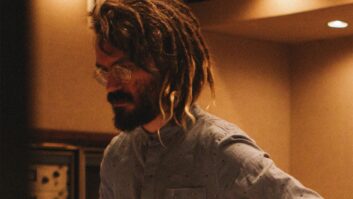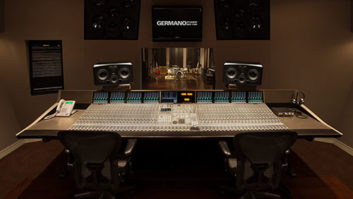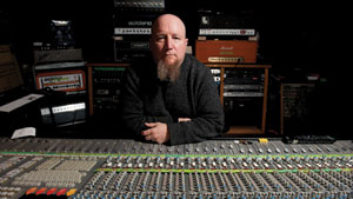As I try to explain to my audio production students: You have democracy and you have dictatorships, and everything falls somewhere in between.
The group vocals are usually double-tracked, but I learned to mix them differently: I set the double-back about 5 dB and used it as a thickener.
A few minutes into a conversation with Jack Richardson, I found myself saying that I would probably feel comfortable buying a used car from him. He replied, “I hope you would. It would be a good car.”
Richardson is about as non-show business as anyone in show business can be and still have made a mark in it. He is avuncular and gentlemanly, speaks in short sentences and waits for you to finish yours first. He is very much the product of his time — he was born in 1929 in Toronto and still lives in the suburb of London, Ontario, with his wife — and of his place: Canada has long endured a frontier-like status vis-a-vis the United States, a condition that affects its entertainment industry, as well. When 90% of the population of the country lives within 100 miles of its long border with the U.S., radio and television signals from the relentless American media inevitably cast long shadows. With the kind of politeness that such proximity breeds, Richardson was more than willing to live life within the boundaries of Canada’s show business to the extent that luck and talent would let him. But luck had other plans.
Richardson started out playing double bass in school orchestras, graduating to local and regional dance bands in the 1940s, like The Westernaires in Toronto. In 1949, he got married and began a family that grew to include four children (including son Garth, who has made his own mark as an engineer for Rage Against the Machine and Red Hot Chili Peppers). By the time he was done as a full-time producer in the early 1980s, Jack Richardson’s discography had swelled considerably: All of the classic hits for the Guess Who, including “These Eyes” and “American Woman”; seminal records for Alice Cooper, including hit songs “I’m 18” and “School’s Out”; three of the most successful Poco albums, which included the hits “Good Feelin’ To Know” and “Crazy Eyes”; Bob Seger’s Night Moves, which would itself be a crowning achievement in any production career (see April’s “Classic Tracks”); and dozens of other records for artists that span genres and decades, including Badfinger, Joe Beck, the Brecker Brothers, the Allman Brothers, Dickey Betts, Michael Bolton, Papa John Creach, Starz and White Wolf.
Today, Richardson continues to teach classes in audio engineering and production, a pursuit he began in 1984 at Fanshawe College in Ontario, though he still picks one local or regional band a year and takes them into the studio. There’s hardly a late-night television commercial hawking greatest hits collections that doesn’t include one or more of his productions; yet, at nearly 72, he still gets a kick out of Toronto garage bands selling records he does with them off the stage after gigs. “After a while, you can’t keep it up like you used to, to make records,” he says. “But it’s hard to not do it at all after you’ve done it so long.”
I want to start with a technical question: Where, exactly, is Canada?
[Laughs.] Just north of Nashville, I think.
What was the music business that you grew up in like in Canada?
After high school, I had started working with Billy O’Connor, a Canadian pop singer, as a bass player. We had five half-hour radio shows a week and later three half-hour television shows a week. But by 1958, it was beginning to become too much like the television business, especially with the introduction of kinescope and videotape. They could prerecord artists, and they didn’t need live shows anymore. I had a family now, and it was getting harder to make a living as a musician. But I still loved music. So I went to work for [advertising agency] McCann-Erickson, first as an account executive. They had a radio show called The Hi Fi Club that was sponsored by Coca-Cola, and I got involved in that, and by the time it moved to television and became The Campus Club, I was the radio and television director for the agency and responsible for the Coke account. The American influence was all over the music and entertainment business. I was working for an American company and handling an American account. There was no sense of a Canadian community in the entertainment industry, and there were very few successful Canadian acts. The Canadian record companies were usually just distribution operations for the American labels.
Did you think about moving to the U.S.? Lots of Canadian artists have done just that over the years.
I thought about Nashville in the mid-1960s. But two of my sons were coming close to draft age, and I didn’t want to chance that then [during the Vietnam era], so I stayed here and rolled the dice.
How so?
Myself and three partners who had been in advertising went off and started our own production company, Nimbus 9. And I had a recording studio in there called Soundstage. We called it that in order to get a film production license that would let us bring all our equipment in duty-free. Once, we got a call from the Customs & Excise Ministry, and we got into quite a panic. I actually went out and rented a 16mm Mitchell camera to make it look like a film studio. Turns out the inspector wanted to see our Eventide Clockworks. It’s a Harmonizer, but it has the word “clock” in it, so that’s what got them interested. Something to do with importing clocks. He came, looked at it, left and we never heard from them again.
So it’s 1968, you’ve already had two careers, never produced a record, then the Guess Who. Did you actually mortgage your house to pay for their record?
That’s true. It was a second mortgage, only $5,000, but that was a lot then. The record cost $9,328 to make.
You remember the exact amount to the dollar?
You do when it’s your money.
How did that collaboration come about?
Coke had been doing a youth radio program, getting successful local artists to record versions of their theme, “Things Go Better With Coke.” Guess Who was one of the groups I approached for that when I was at the agency. The band had had some success in Canada but was about to break up. They had gone on a tour of the UK, and the promoters were shaky and the band lost their shirts. Later, with Nimbus 9, I approached Coke about doing a self-liquidating promotion, doing a record and putting the Guess Who on one side and a band from Ottawa called The Stacattos (who would later become the Five Man Electrical Band and have a hit with the single “Signs”) on the other. We called it “Wild Pair.” You would send in six bottle caps and $1.25 and you’d get an album. They sold about 130,000 of them, which was quite a lot. When I decided I wanted to produce a real album with them, first we had to buy out their record deal from Quality Records for $1,000. We started recording and had talked with RCA in Montreal, but all we had to start with was independent distribution, and we never made any money. I thought about taking the group to New York. I had a relationship with Phil Ramone, who I had met taking some courses at the Eastman School of Music [in Rochester, N.Y.], and I had done some jingle work at his studio, A&R. That’s when I mortgaged the house and took the band to New York. I wanted to use the big Studio A at A&R. Phil told me it was booked, but that they had just built a new room. He told me, “If it sounds good, pay me; if not, don’t.” That’s a win-win situation. The studio had a custom-made Neil Muncey console and an Ampex 8-track. David Greene was the engineer. We did the whole record [Wheatfield Soul, which spawned the hit “These Eyes”] in five days.
Are you an engineer?
To a degree. I engineered if worse came to worst. Brian Christian did most of the records I worked on after “American Woman” with Guess Who. Before that, it was David Greene and John Woram.
Lyrically, “American Woman” — yours and the group’s first Number One record — was not exactly complimentary of American women…
There’s an interesting story about that. After it was a hit, the band was invited to play the White House at a reception [for Prince Charles]. They were going to play that song until the manager got a call from the State Department specifically demanding that they not play it. [Apparently, according to a note on the allmusic.com Website, first lady Pat Nixon was the one who nixed the song.]
What other studios did the band use?
The group’s first record after signing with RCA [Canned Wheat] started at the old RCA studios on [West] 24th Street in Manhattan, which had one of the first Ampex MM1000 16-track decks. But the union engineers there were so bad, the distortion was so evident, that I eventually refused to work there anymore. I actually pulled out in the middle and went back to A&R, where we recorded what would become the two hits off that record, “Laughing” and “Undun.” Later, RCA steered me to the new RCA studio in Chicago, where I met Brian Christian.
You were developing as a record producer. How would you characterize your style?
I look at it as not so much a stamp of who I am as who the band is. I’m more like a traffic cop in the studio. As I try to explain to my audio production students: You have democracy and you have dictatorships, and everything falls somewhere in between those two dimensions. I lean more toward democracy. That’s how I could do so many different kinds of artists, from the Irish Rovers to Manowar.
You were new as a record producer. Did RCA ever try to bring in a more experienced producer?
No, not once. The band and I had a very good relationship. Actually, they self-destructed before something like that could ever happen: The label threw a party at Sardi’s the night after the band did a gig at the Fillmore East, and that’s when Randy [Bachman] told the new president of RCA he was leaving the band.
You were an ex-musician and a former advertising guy who got lucky once. Could it have ended there?
I don’t think so. I just tend to interface with people very well, and I really liked music.
Did you tap into your advertising experience as a record producer?
Oh yeah. Every session. Even though you’re dealing with the same kind of music and the same instruments, you’re always dealing with four or five people in a band, individuals who have varying degrees of psychosis, and you act accordingly.
The success of the Guess Who records led to Alice Cooper contacting you. Cooper was already making a name with shock value. How did you approach those records you did with him?
Shep Gordon, Alice’s manager, contacted me. [Alice] was the Darth Vader of the music business at the time, but all I think I said was, “We don’t have to kill chickens onstage to make records.” But it was these productions that we brought Bob Ezrin in on, as a kind of apprentice. I did Muscle of Love; Bob and I did Love It to Death and Killer together. I had agreed at first to do four sides with Alice. We did them at the RCA studios in Chicago, and Brian Christian was the engineer again, though later we also did some recording at Record Plant in New York, and Muscle of Love we started at Sunset Recorders in L.A. and finished at Record Plant. On the first session, we had Alice come in dressed in full Alice Cooper regalia, and Brian could never bring himself to call the guy “Alice.” I don’t put much credence in superficial appearances. I’m more interested in what they’re doing musically and if they’re serious about that. We actually became pretty good friends.
How was Cooper different as a production client from Guess Who, besides sartorially?
These were the records I moved to 24 tracks on. And the band was pretty raw players by comparison. That was something of a surprise. I’d have thought that a band who had already made three or four records would have been better players. I’m talking about issues like getting the guitars in tune. But the shock value of the music actually overcame these deficiencies. Still, to make the records, I needed a very sharp razor blade for edits. There was no Pro Tools then. I often took a chorus from one part and a verse from another and edited them together. We often worked from a tape drum loop. The albums were done much more as overdub sessions than ensemble playing. We also brought in some outside players, like Rick Derringer on Killer and Jack Bruce on Muscle of Love. But they were also attracted by Alice’s notoriety. Alice, himself, was a very good singer in terms of knowing the songs and giving a good delivery. He was also a pretty nice guy. I would have brought him home to meet my mother. He was also a soap opera fanatic — watched them all the time in the studio.
You were developing technical preferences by then?
Certain ones. I loved the API 550A EQs, the most musical EQ ever made. Certain microphones, like the [Neumann] KM84. I used them on drums, and people thought I was nuts.
From heartland pop/rock to the beginnings of androgynous rock and then to glossy country/rock: What was working with Poco like?
I got a call from the management and flew out to Boulder, [Colo.], where [bandmembers] Richie Furay and Paul Cotton lived. Poco was a good example of how to structure songs as a producer. We all had a great feeling about the song “Good Feelin’ To Know.” It was designed to be a radio song. For that, you have a limited amount of time, and you have to get the basic concept across reasonably soon; in two minutes, not five. I had them speed it up and cut the verses, which had tended to ramble a bit. It wasn’t major brain surgery, but sometimes a band can’t see the forest for the trees, and that’s what a producer is for. You can make small suggestions that turn into big changes.
Poco was vocals and pedal steel. How did you deal with those elements?
Poco’s vocals and harmonies were very good. But sometimes the simplest was best. On “Crazy Eyes,” Paul Cotton did a scratch pilot vocal, and we then tried for three days of overdubs to get a final and ended up using the scratch vocal. The group vocals are usually double-tracked, but I learned to mix them differently: I set the double-back about 5 dB and used it as a thickener, spreading them out in the image a bit and also panning the echo, to give it dimension. Sometimes we triple-tracked them. For the pedal steel, I liked what Rusty [Young] played. But the thing about any pedal steel player is that they have complete control over the volume of the instrument constantly, because of the volume pedal. I had to ride that, sometimes put a compressor on it to keep it in check. I wanted the steel to be part of the overall ensemble sound, not a highly visible instrument. I mixed it in with string quartets at times, and it sounded amazing.
What became of your studio?
We sold it in 1980, along with the mastering facility we also had there. It had an AudioTronics console on which we had taken out all the transformers, except for the phase-reverse transformers, and replaced the mic pre’s with heavy-duty Jensen mic pre’s. We also had a direct-to-disc label up there, so we wanted a very pure signal path. That studio did the Guess Who stuff, but it also was rented out by a lot of other artists: Bob Ezrin did Peter Gabriel’s “Salisbury Hill” there, for instance.
So why did you back away from producing?
I guess I fell out of it almost as abruptly as I fell into it. I just reached the point where I could no longer justify being away from home for two to three months at a time. I was getting tired of the 15- to 20-hour days. I had been on the advisory board for Fanshawe College for some time and started teaching there in 1984. We have two full studios there and Pro Tools suites. I never had illusions of glory from producing records. I did it because I liked working with people, just as I did with advertising, and just as I do now teaching them.
And Garth, your son, has continued the tradition.
A few of our kids have gone into music, and we were delighted. It’s not something we encouraged them to do. Garth’s had good success, but he’s fallen into something I tried to avoid: He’s become the heavy metal and alternative music guy; he’s been pigeonholed. Now you become a specialist in a type of music based on your first success, and his first was Rage Against the Machine. I remember him calling me to tell me how interesting it was when he finally got to do a string session. I guess when I was producing, there wasn’t that kind of mentality that pigeonholed someone so quickly. You used to have to do a lot of different things to survive. I guess that kind of nonspecialization no longer exists.
(Author’s Coda: A generational perspective is obviously at work. Garth Richardson recalls the day his father came home from a session in 1968 and exclaimed, “Now they have three tracks! What’s next?”)
Dan Daley is Mix‘s East Coast editor.







